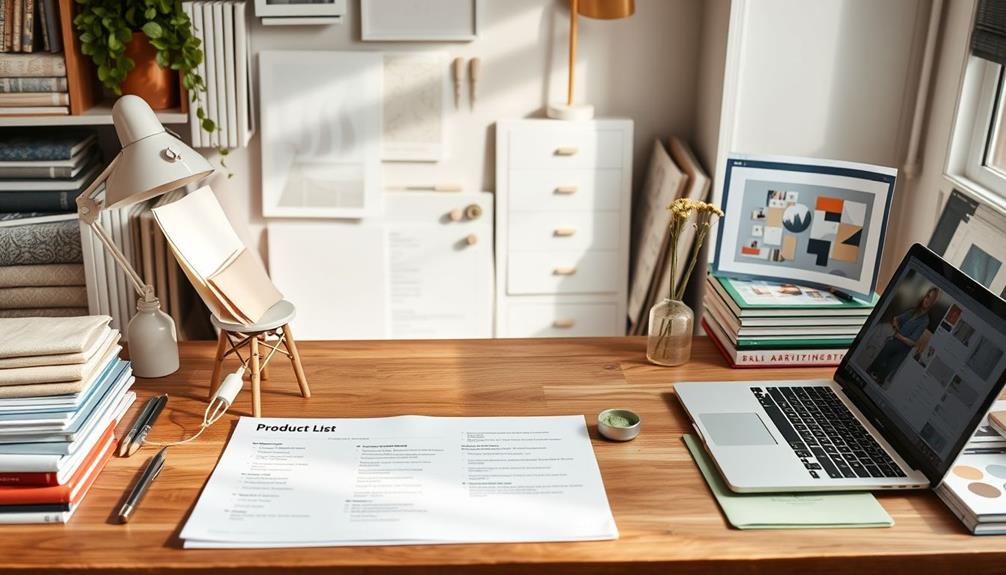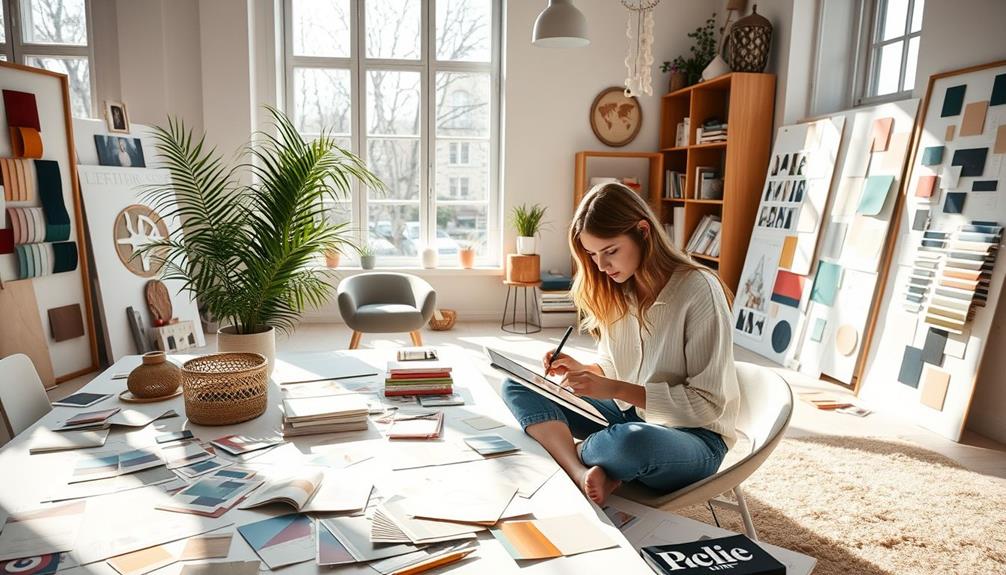To plan your interior design project, start by defining your scope and goals. Decide whether you're renovating or building new, and outline what areas need attention. Set a realistic budget, ideally 7-10% of your home's value, allowing for the unexpected. Gather inspiration from platforms like Pinterest, and create a moodboard to visualize your ideas. Don't forget to conduct space planning with accurate measurements and consider usability. Finally, compile a product list and communicate with professionals to guarantee everyone's on the same page. There's plenty more to explore to streamline your design journey. When it comes to executing your interior design project, it’s crucial to stay organized and focused. Consider using business plan tips to set clear objectives, timelines, and milestones for each phase of the project. This will help keep you on track and ensure that everything is completed efficiently and within budget. Additionally, don’t be afraid to seek advice and assistance from experts in the field to make sure your project is a success.
Key Takeaways
- Define the project scope by identifying specific areas for design or renovation and establishing a realistic budget for expenses.
- Gather inspiration from various sources, creating a mood board to visually represent preferred styles, colors, and materials.
- Conduct space planning by measuring dimensions and identifying functionality zones to enhance usability and accessibility in the design.
- Experiment with color schemes and compile a product list, organizing items by category for clarity during purchasing and budget management.
- Engage with professionals for tailored space plans and maintain effective communication to align goals, gather feedback, and monitor project progress.
Define Project Scope
Defining your project's scope is essential for a successful interior design endeavor. Start by determining whether you're building a new home or renovating an existing space, as this greatly influences your design decisions.
For those looking to enhance their spaces, consider utilizing a thorough suite of services that caters to both homeowners and commercial developers. Next, identify the specific rooms or areas needing attention. A thorough plan guarantees you don't overlook any necessary spaces.
Establish a realistic budget to guide your project. Aim to allocate about 7-10% of your home's value for interior design expenses, or up to 25% if you're opting for designer-level finishes. This budgeting will also help you make informed decisions about materials and furnishings.
Set clear expectations by outlining your desired outcomes and establishing a timeline for completion. Consider any potential constraints, such as construction regulations or logistical challenges that could impact your project scope.
Addressing these factors early on will help you avoid unexpected hurdles down the line.
Gather Inspiration

To gather inspiration for your interior design project, start by exploring visual platforms like Pinterest and Instagram to collect ideas that reflect your style.
Consider drawing inspiration from various sources, such as travel and nature, to enrich your design perspective.
Once you've gathered enough visuals, create a mood board to organize your favorite elements and set a clear design direction.
Sources for Inspiration
Inspiration can strike from countless sources, making your interior design project both exciting and personal. Start by exploring visual platforms like Pinterest and Instagram, where you can discover diverse design ideas that resonate with your style. Collecting visual references from these platforms helps you curate a rich tapestry of inspiration.
Don't forget to draw from your travels, nature, and even fashion. Each experience adds depth to your interior design vision. Creating a mood board is an effective way to visualize your preferred styles, colors, and materials, ensuring a cohesive look.
Delve into design blogs, magazines, and online resources for expert insights and curated collections that can enhance your project. These sources offer valuable tips and the latest trends, guiding your choices as you refine your design.
Attending design exhibitions and home shows allows you to experience ideas firsthand and gather inspiration from professional displays. By engaging with these inspiration sources, your project will reflect your unique aesthetic while incorporating elements that truly resonate with you.
Embrace the journey of collecting inspiration, and you'll set a solid foundation for your interior design project.
Visual Reference Collection
Once you've gathered a wealth of ideas, it's time to focus on how to organize and refine your inspiration into a visual reference collection. Start by utilizing platforms like Pinterest and Instagram to explore a vast array of visual inspiration that resonates with your personal style.
Collect visuals from diverse sources, including travel photography, nature landscapes, and fashion, to broaden your perspective. For instance, consider exploring breathtaking destinations like those found in island getaways that promise adventure and luxury.
Creating a mood board is essential for visually compiling your preferred styles, colors, and materials. This will help clarify your design vision and direction. As you build your mood board, incorporate a mix of design elements and themes to express your unique aesthetic and desired atmosphere for the space.
While planning your project, pay attention to common themes that emerge from your creative collection. Identify which materials and design elements can be integrated to translate your gathered inspirations into a cohesive style.
Moodboard Development Techniques
Creating a moodboard is an essential step in the interior design process that helps you visualize and refine your ideas. To gather visual inspiration, utilize platforms like Pinterest and Instagram to explore a variety of design styles that resonate with your vision.
Collect materials from diverse sources—travel photos, nature, and fashion—to create a rich pool of inspiration for your moodboard.
Once you've gathered visuals, organize them into a cohesive layout that showcases your preferred colors, materials, and furniture styles. This will help communicate your design concept clearly.
Experiment with different design elements and arrangements within your moodboard to see how they work together and influence the overall tone of your space.
Regularly seek feedback on your moodboard from team members or clients. This guarantees alignment with their vision and allows for necessary refinements before you finalize your design direction.
Create a Moodboard

Creating a moodboard is your chance to gather visual inspirations that reflect your design vision.
You'll want to experiment with color schemes and compile product references to see how everything works together.
This visual tool will help you keep your project cohesive and aligned with your goals.
Gather Visual Inspirations
Gathering visual inspirations through a moodboard is an important step in shaping your interior design project. A moodboard acts as a visual collage that showcases various design elements, colors, materials, and furniture styles that convey your desired aesthetics. To create a diverse range of inspirations, gather images from magazines, online platforms like Pinterest, and personal photographs.
You can use digital design software or a physical board to assemble your moodboard, making sure it's visually appealing and easy to understand. Here's an example layout to inspire you:
| Colors | Materials | Furniture Styles |
|---|---|---|
| Warm Neutrals | Natural Wood | Mid-Century Modern |
| Bold Blues | Textured Fabrics | Industrial Chic |
| Soft Pastels | Metal Accents | Scandinavian |
Once your moodboard is ready, gather client feedback to refine your design direction. This step helps guarantee that your vision aligns with their preferences. A well-crafted moodboard not only communicates your design concepts to clients and collaborators but also serves as a crucial reference throughout the project, maintaining consistency in style and tone.
Experiment With Color Schemes
When it comes to experimenting with color schemes, a moodboard is your best ally in visually combining different hues, materials, and textures. It aids you convey the desired atmosphere of your interior design project.
To create an effective moodboard, consider these key steps:
- Collect Color Swatches: Gather a variety of colors that align with your design vision, such as those that evoke the cozy ambiance of a teenage girl room.
- Incorporate Textures and Materials: Include samples of fabrics, finishes, and other materials that complement your chosen colors.
- Apply Color Theory: Use principles like complementary colors to guarantee harmony within the space.
- Seek Feedback: Share your moodboard with clients or team members to refine your choices based on their insights.
Utilizing digital tools and templates streamlines the process, making it easier to organize and visualize your color schemes.
Experimenting with different combinations on your moodboard allows you to iterate on design ideas and find what resonates best.
Compile Product References
A well-compiled moodboard acts as a powerful tool that visually communicates your design intentions and product choices. Start by gathering inspiring imagery and product references that align with the project's design direction.
Focus on incorporating colors, materials, and furniture styles that convey the desired aesthetic while keeping your client's vision in mind. Utilizing tools like the Études Architect App can enhance collaboration during this process.
Use online platforms, magazines, and client-provided materials to compile a diverse range of visuals. Your moodboard should serve as a visual representation of your ideas, making it easier for clients and team members to understand the overall concept.
Be certain to include links to specific furniture, artwork, and lighting options for quick reference during the selection process.
As you present the moodboard, gather feedback from both your clients and team members. This input is essential for refining your ideas and guaranteeing the moodboard meets the project's goals.
Develop a Brief

Developing a brief is an essential step in any interior design project, as it sets the foundation for success. A well-defined brief outlines the project's style, goals, and timeline, guiding the entire design process.
For instance, incorporating popular trends like modern farmhouse decor can influence your design choices considerably. Here are four critical components to include:
- Goals: Clearly specify what you want to achieve with the design.
- User Information: Document the needs and preferences of the occupants to inform your decisions.
- Visual References: Gather images and styles that resonate with your vision to guarantee everyone is on the same page.
- Deliverables: List what you'll provide at the project's end, including floor plans and other essential documents.
Once you've crafted the brief, finalize it and share it with your team via a read-only link. This encourages collaboration and invites feedback, fostering a sense of ownership among team members.
Establish a Budget

Establishing a budget is essential for any interior design project, ensuring you stay on track financially while achieving your vision. Start by determining your initial budget estimates, ideally allocating 7-10% of your home's value for design expenses. If you're aiming for designer-level finishes, consider increasing that to 25%.
To navigate potential overages, it's wise to add an additional 18-20% cushion. Using personalized budget worksheets can help you track expenses and define your financial parameters effectively.
Understanding average costs for specific rooms will aid in informing your budgeting decisions. For instance, the living room typically incurs the highest expenses.
Here's a simple breakdown to guide you:
| Item Category | Average Cost Range | Price Category Mix |
|---|---|---|
| Living Room | $5,000 – $15,000 | Mid-range + Designer |
| Bedroom | $3,000 – $10,000 | Mid-range + Designer |
| Kitchen | $7,000 – $20,000 | Mid-range + Designer |
Mixing price categories allows you to stay within budget while still achieving the desired aesthetics.
Conduct Space Planning

Once you've set your budget, it's time to focus on space planning. This vital step guarantees that your design meets the needs of the occupants while optimizing functionality.
Here's how to get started:
- Measure Room Dimensions: Accurately measure your space and document permanent features like windows and doors.
- Utilize Digital Tools: Use software like Planner5D or SketchUp to create a detailed floor plan, reflecting how each area will be used.
- Identify Activity Zones: Designate specific activity zones within your layout for better functionality, guaranteeing each zone serves its intended purpose effectively.
- Assess Natural Movement Patterns: Evaluate the flow within the space to enhance accessibility, prioritizing usability over aesthetics.
Compile a Product List

Compiling a product list is essential for bringing your interior design vision to life. Start by gathering feedback on your moodboard, ensuring that the materials and products align with your client's vision and project goals. Create a thorough product list that includes links to specific furniture, artwork, and lighting options to streamline your selection process.
Organize your product list by category for clarity and ease of reference during the purchasing phase. A visual shopping list format will help you track items as they're purchased or confirmed, enhancing your budget management and inventory control. Regularly revisit and update the product list based on client feedback and project developments to stay aligned with your design objectives.
Here's a sample product list layout to reflect upon:
| Category | Items |
|---|---|
| Furniture | Sofa, Dining Table |
| Decor | Wall Art, Throw Pillows |
| Lighting | Floor Lamp, Pendant Light |
Engage With Professionals

Engaging with professionals in interior design can elevate your project to new heights. When you collaborate with a professional interior designer, you unveil a wealth of expertise that can transform your vision into reality.
Here are four key benefits of working with a designer:
- Tailored Space Plans: Designers create customized layouts that maximize functionality and aesthetics while adhering to building codes.
- Cohesive Design Vision: They interpret your client inspirations, ensuring every element aligns with your desired aesthetic.
- Efficient Project Execution: With their experience, designers navigate potential pitfalls, suggesting cost-effective solutions to keep your project on track.
- Budget Adherence: Regular communication helps maintain budget adherence, allowing for structured check-ins that manage expectations and progress.
Communicate Effectively

To guarantee your interior design project runs smoothly, effective communication is essential from the start. Establish clear communication channels to confirm all team members and stakeholders align with project goals and expectations.
Create a detailed brief that outlines style preferences, budget constraints, and deliverables to keep everyone informed and focused.
Schedule regular check-ins and updates to discuss progress, address concerns, and gather feedback. These meetings foster an open dialogue, allowing you to navigate challenges together.
Utilize collaborative tools and platforms, such as shared boards or project management apps, to centralize information and provide real-time access to project details. This way, everyone stays on the same page.
Encourage ongoing discussions by inviting team members to contribute ideas, ask questions, and provide input. This collaborative environment enhances project outcomes and confirms that everyone feels valued.
By prioritizing communication, you'll create a strong foundation for your design project, making it easier to adapt to changes and keep the momentum going.
Conclusion
Planning an interior design project might seem overwhelming, but breaking it down into manageable steps makes it achievable. By defining your scope, gathering inspiration, and engaging with professionals, you're setting a solid foundation for success. You might worry about staying within budget, but remember, smart planning allows for flexibility. Prioritize your needs and find creative solutions that reflect your style without breaking the bank. Embrace the process; your dream space is within reach!








